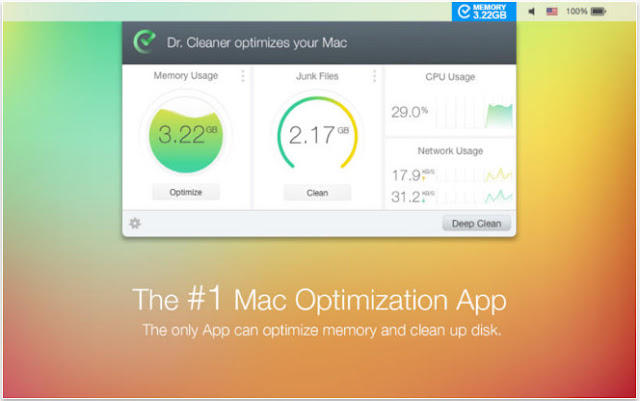1. Dr. Cleaner
Dr. Cleaner is the ONLY all-in-one FREE App that offers Memory Optimization, Disk Cleaning and System Monitoring to keep your Mac optimized for the best performance.
With a brand new user interface, Dr. Cleaner provides an easy-to-use way to optimize the performance of your Mac! Also, with Dr. Cleaner, you can easily view real-time network usage and CPU usage in the menu bar.
USER COMMENTS
"It removes unwanted and useless files to clean up your mac. It does everything the description says." — Kamil.D from Australia
"Very simple - very effective. Easy to use and great way to keep your Mac optimised." — Damo1193 from U.K.
"Simply the best App I have ever used…" — Jani from Germany
PRIMARY FEATURES
[Smart Memory Optimizer]
• 1-click memory optimization
• Instantly reclaim memory from closed Apps
• Identify Apps that use a significant amount of memory
[Junk Files Cleaner]
• Quick disk clean from status bar menu
• Clean temporary files, incl. logs, mail caches, iTunes and iOS temporary files, etc.Empty Trash for current user
• Clever detection of remaining files after deleting Apps
• Clean trash in removable storage
[Big Files Scanner]
• 1-click scan of big files (customizable size from 10 MB and above)
• Multiple filters of size, date, name and type
• Local files in sync with your cloud drives can also be found
• Protected files* will not be deleted
[* Important big files can be "locked" into the protected list to avoid false deletion.]
[Duplicate Finder]
• Thorough and quick scan — it has the fast and accurate scanning technique that covers your entire home folder.
• Smart and accurate selection — duplicates are selected not only by file names but also by their contents. Files are shown in detailed previews. it can also help you "decide" which copy to delete by presenting "Auto Select" button.
• Easy and safe decision — duplicates can be sorted by file type and listed in their full route for you to track. You can decide which way to clean these files - either by putting them in to Trash or deleting them permanently.
Untuk download gratis di Apps Store silahkan KLIK DISINI!
2. Bandwidth+
• Zero configuration required. It just works.
Bandwidth+ is a simple app so only tracks the network usage on the Mac it is running on. If you are tethered to an iPhone then it will count the usage while tethered.
At the moment local network traffic is not ignored so Time Capsule backups are counted. A future version will be smarter and ignore Time Capsule data.
Untuk download gratis di Apps Store silahkan KLIK DISINI!





























